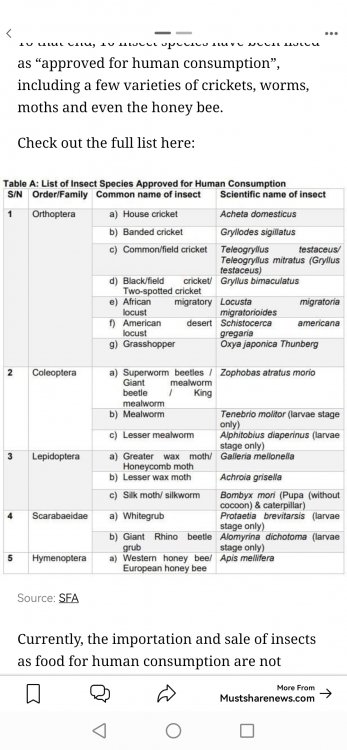Search the Community
Showing results for tags 'consumption'.
-
Yesterday, while listening to my favourite podcast (No Such Thing As A Fish), I learnt a shocking, incredible and downright unbelievable fact. Here’s the fact: Singapore is number one in the world in bottled water consumption and spending per capita. Here’s the kicker: It’s not even close. According to a UN study published in 2023, Singapore’s 1,129 litres and $1,348 per capita in 2021 is miles and away higher than second place Australia (504 litres and $386).The graphs illustrating this are hilarious. Singapore is so far out from all the other countries that they have to create an additional graph segment just for us. We are quite literally not even on the same scale as the rest of the world. When I first heard this fact, I literally could not believe it. How is that even remotely possible? I don’t think I buy more than one bottled water a month, and most people I know around me don’t drink bottled water on a highly regular basis. In fact, I cannot think of anyone I know that solely drinks bottled water. Think about it. 1,129 litres per capita means that an average Singaporean drinks 3.09 litres of bottled water A DAY. I don’t even think that many people drink 3.09 litres of any water a day. Which brings us to a very simple question: How is this possible? When The Straits Times reported on this in 2023, one reason provided was the relative affordability of bottled water in Singapore (true), as well as it being widely accessible (also true). However, the article also cited a report that indicated that “only 3 per cent of the 1,000 households surveyed actually consumed bottled water.” That seems inherently contradictory, and the article does little to offer any clear resolution. I’ve probably spent way too much thinking about this, but I would like to propose some possible explanations (going off the assumption that the UN think tank’s methodology is correct). To be clear, Singapore isn’t the top consumer or spender by volume. USA is the top consumer and spender (61,418 million litres and 63,844 million USD respectively). Singapore is 12th in terms of total volume consumed (approx. under 6,000 million litres), and sixth in terms of bottled water sales (approx. 7.4 million USD). My guess is that the calculations are based on a total per country calculation of consumption and spending, divided by population. That’s how ‘per capita’ works, essentially. Clearly, one important thing to point out is our population size. Because we are significantly smaller than countries like USA/China/Indonesia (the top three in both categories), once you calculate per capita, our numbers shoot up. That’s unfortunately a mathematical reality. But, there is still the obvious question of where exactly that spending and consumption is happening. I don’t think it’s the everyday you and me (how much bottled water are you consuming daily???). I believe the answer is… corporate. Workplaces, offices, as well as events. Think about it. Many workplaces and offices have bottled water in large quantities – both in the typical 500ml bottles, as well as those big 19L bottles for water coolers. Our previous office space used those very same water coolers (we’ve transitioned now to a filter system), while boxes of 500ml bottles sit in the storeroom for when guests visit. And Singapore have SO MANY OFFICES. Not just in the CBD, but everywhere around the island. And this isn’t limited to offices. Retail and hospitality has to also be taken into account. It is typically considered courtesy to offer a guest/customer water to drink, right? I am surely guilty of this when walking into car showrooms when collecting test cars. And, I think another major element of consumption is during events. Singapore is purposely big on events – MICE events, as well as all kinds of activities otherwise (think F1, National Day, marathons, whatever other events you can think of). And of course, these events are not just catered to locals, but to international guests as well. At any of these events, you can easily expect not just cartons, but pellets and even full containers of bottled water. And of course, tourism. Just as you would likely buy water instead of carrying a water bottle around when on holiday, the same is likely true for tourists coming in to Singapore. There’s just a lot of them, and not that many of us locals to mathematically balance the scales, so to speak. Once you take all of that into account, then the numbers start to make a bit more sense. While the average Singaporean probably does not buy bottled water at their local kopitiam every day, there are still many instances of us consuming bottled water, at last on a national level. And while we may not be individually responsible for the spending and consumption, we cannot also ignore the reality of our collective spending and consumption on a national level. The report is more concerned about issues like clean water availability. However, the Singapore numbers reflect something else entirely - the hyper-modernity of our little city, and the hyper-consumption that follows. With our dense concentration of high-rise office buildings, the constant in and out of VIPs from all over the world, as well as the endless major events taking place all around the country, that certainly drives up bottled water demand and consumption. Our hyper-modernity makes for an environment where immediate and easy access to ‘quality water’ becomes almost fetishised, precisely because we don't have to worry about scarcity. Additionally, unlike huge countries like USA and China who may have rural areas without ready access to bottled water that effectively ‘balance’ out their statistics, we don’t have any such things. The consequent result is that the scales are tipped heavily toward consumption. There’s no ‘bell-curving’ Singapore. Factor in our low population relative to these massive countries, and those shocking per capita numbers start to make a bit more sense. Hyper-consumption, of course, leads to the inevitable matter of waste – specifically plastic pollution (another important issue highlighted within the report). While recycling certainly happens, it’s hard to negotiate the sheer scale of what we, collectively as a People, are dealing with. Here are some pertinent quotes from the report: “about 85% of all plastic bottles sold become waste” “Microplastics, of which PET makes up a part, comprise over 80% of the annual plastic pollution in the environment, around 22 million tonnes in 2019” “It is estimated that humans ingest an amount of plastic equivalent to the size of a credit card on a weekly basis” “Since the 1950s, only 6.5% of all plastics produced have been recycled and today, only 14% is recycled” And while some countries like Norway and Switzerland have plastic recycling rates over 80%, Singapore’s plastic recycling rate is… six. Not 60. 6 percent. I’m no eco-crusader. But I do think this single statistical instance of bottled water does cast a stark light on our hyper-consumption. And while you may often hear (or even make) the argument, “I’m just one person, what difference can I make?”, I think that’s almost entirely beside the point. There are certainly people out there to change the world. I am not one of them. However, I do believe that each of us individually can make an effort to change ourselves. Every little bit counts. And to be clear, I’m not for a moment saying that people should suddenly boycott bottled water, or drastically change your way of life. Rather, it’s more about being just a little bit more aware of your individual consumption patterns, and not simply and blindly accept endless convenience. Singaporeans will continue to consume bottled water, myself included. But if we can each of us just make a tiny effort to do it less, to resist that easy convenience where possible, then perhaps we as a country can move the needle ever so slightly. We love to be number one in the world. I just don't think this is one of those instances where being number one is all that good. ~ Desmond Images: Wikimedia Commons, National Environment Agency, United Nations University
- 1 comment
-
- water
- bottled water
-
(and 3 more)
Tagged with:
-
SFA Considering Allowing Insects For Human Consumption In S’pore, Now Seeking Public Feedback https://www.straitstimes.com/singapore/consumption-of-insects-like-crickets-beetles-may-soon-be-approved-in-spore-sfa#:~:text=Singaporeans may soon be able,consumption and as livestock feed. No image because I can't bring myself to save the picture and upload here. 🤮 Those who’d like to contribute may email SFA at [email protected] or [email protected]. The deadline for submissions is 4 Dec at 6pm.
- 54 replies
-
- 14
-

-

-
.png)
-
Not only the processed meat are dangerous. The commercially farmed livestocks and aquaculture products are also dangerous. There is over-usage of enzymes, growth hormones and medication, including regular dosage of antibiotic, in the livestock industry. They are constantly increasing the cycle output and animal nutritionist are constantly under pressure to add new additives to the feeds or injection to promote body mass growth of the livestock. Fast mass body growth means shorter production cycle and increase profit for the farmers. Eat meats in moderation and at your own perils. Processed Meats Declared Too Dangerous for Human Consumption The World Cancer Research Fund (WCRF) has just completed a detailed review of more than 7,000 clinical studies covering links between diet and cancer. Its conclusion is rocking the health world with startling bluntness: Processed meats are too dangerous for human consumption. Consumers should stop buying and eating all processed meat products for the rest of their lives. Processed meats include bacon, sausage, hot dogs, sandwich meat, packaged ham, pepperoni, salami and virtually all red meat used in frozen prepared meals. They are usually manufactured with a carcinogenic ingredient known as sodium nitrite. This is used as a color fixer by meat companies to turn packaged meats a bright red color so they look fresh. Unfortunately, sodium nitrite also results in the formation of cancer-causing nitrosamines in the human body. And this leads to a sharp increase in cancer risk for those who eat them.A 2005 University of Hawaii study found that processed meats increase the risk of pancreatic cancer by 67 percent. Another study revealed that every 50 grams of processed meat consumed daily increases the risk of colorectal cancer by 50 percent. These are alarming numbers. Note that these cancer risks do not come from eating fresh, non-processed meats. They only appear in people who regularly consume processed meat products containing sodium nitrite. Sodium nitrite appears predominantly in red meat products (you won
-
Hi, we have all heard of various cars and their respective FC blah blah blah, but alot of them are hearsay or heard from someone from internet of review or from internet. And i realized not all the time these hearsay or myths are accurate. Example, i used to drive the old Nissan Sunny, before i buy, i already heard many hearsay or comments from internet saying it is a heavy petrol drinker. But for me, after buying it, i usually pumped 33-35litre of full tank, and i can cover average about 400-420km. It wasn't that bad actually right? And now i am driving Elantra, 2011 model. Full tank about 40-42litre...and i can cover 520km per full tank. I don't consider this very good. How about you guys? What car you driving and how much you spent every full tank and how much can it cover you?
- 293 replies
-
- 1
-

-
- fuel consumption
- fuel
-
(and 2 more)
Tagged with:
-
Hi all guru, i am driving a honda stream 1.8x 2009 model. Just purchase this car from close family member. He is a careful driver thus i believe that the car has no previous problem. But recently i realise that my car has slight longer time (1second more) to start engine when i turn on the key. SPark plug was removed to check and is in good condition. Also, i experienced loss of power when going from 2000 rpm and above..specially when im trying to change lane and speed up. The car behave like "a buffalo", cant accelerate as fast and car from behind already came near me!! And sometime i tried to rev the rpm to 5-7rpm, i feel that the car is "free gear" ...i feel that the engine just keep turning at high speed but it feels that it nt engaged in any gear **(hard to explain this feeling. the car seems to be at free gear which i cant really control the speed but to let go accelerator then the accelerator seems to be engaged into the gear for me to control the speed) I tried to top up full and drive slowly. Full tank is about 470-480km. But the consumption sometime still state 9.9-10.2km/l I heard from my close family he used to get 11-12. Would like to check if anyone has this problem for high fuel consumption loss of power when overtaking (*seriously mus solve this problem) thanks in advane!!
- 45 replies
-
- honda
- loss of power
-
(and 7 more)
Tagged with:
-
Hi guys, I was about to commit a second hand about 2 years old A6 1.8 TFSI Ultra Edition. What is the pros and cons of this car? Tried searching but to no avail. Seems like there not much mentioned. Also, do you guys know how to differentiate the Matrix headlight? Heard that this is a very expensive option. Any comments and advises are welcome. Many thanks in advance.
- 22 replies
-
- audi
- ultra edition
-
(and 6 more)
Tagged with:
-
For those driving how the FC for this suv? Thinking of switch to 20' wheels, anyone can share before and after when u change ya rims?
-
- fuel
- consumption
-
(and 1 more)
Tagged with:
-
I am currently considering b/w these 3 models-> BMW 320i, E200CGI or an audi A4. Does anyone know which brand gives the best fuel consumption?? For servicing, i know all will be expensive.. but is there a difference in cost b/w these 3?? (Generally, which will be more expensive in servicing?) Thanks
-
Has anyone keep a log of all petrol fill up, average consumption and cost involved ? I have all details in a great program.. called automobil ( For Palm )..It calculate everything from head to toe with graph.. Here the results of all the data since day 1 until now.. Here's mine below.. Current Fuel Eco ( per l ) : 17.3km Average Fuel Eco ( per l ) : 17.1km Avg Distance ( Month ) : 2,475km Avg Distance ( Year ) : 30,107km ( Computed ) Avg Cost ( Month ) : SGD $187.82 Total Cost : SGD $763.82 Cost per km : SGD $0.075 Date of last fill up : 3/10/03 Mileage of last fill up : 10,078 km NEAT NEAT Program... track my mileage,cost and averages.. If you want the program..I will attach it... its SHAREWARE..
- 103 replies
-
- Petrol
- Consumption
-
(and 3 more)
Tagged with:
-
Hi there, i'm having terrible fuel consumption with my toyota camry. even when i drive "conservatively", it is doing about 7-8km/litre. completely horrible. what are your experiences?
- 91 replies
-
- fuel
- consumption
-
(and 4 more)
Tagged with:
-
Hi all, Due to lifestyle/commitment change, my traveling distance per day has increased to at least 55 to 60km in the weekdays. Currently driving a Hyundai Avante left around 1 year to scrap. It's give me about 11+km/l depending on traffic, recently like getting worst. I know now alot of new cars with better lower cc engines can give up to 20km/l paper spec! Choon boh? Hybrid got so good? I need advise from the forum gurus. Which new car now can really give me good fuel comsumption but still driving at least like my avante? basically I'm looking at this requirements: - Real life FC better thatn 16km/l (not paper spec, switch off AC, controlling pedal carefully those type. I want realistic normal driving in SG) - Still Driving a like 1.6 (Avante power actually not bad) - Size around like Avante (sedan or hatch) - Price around 100k +/- 10k - don't need other bell and whistle. Such cars exist? How is Hybrid but don't have such price right? I try to find same topic but dun have. Hope the good bros here can advise. Thanks in advance.
- 66 replies
-
- fuel
- consumption
-
(and 5 more)
Tagged with:
-
Model-DJ Tenashar faces drug-related charges including cocaine consumption SINGAPORE - Well-known local model and club DJ Tenashar has been taken to court on drug charges. The former FHM Singapore cover girl, whose full name is Debbie Valerie Tenashar Long, is facing two counts of drug consumption. One involved cocaine and the other involved psilocin - a substance found in most psychedelic mushrooms. The 32-year-old Singaporean is also facing one count each of importing psilocin - a controlled drug - and being in possession of nimetazepam or Erimin-5. Long, who was first charged in court on May 26, allegedly committed the offences in October 2015. She is now remanded at Changi Women's Prison and appeared in court via video-link on Friday (June 22). The court heard that the prosecution was not ready as the Agri-Food and Veterinary Authority is currently looking into a possible animal cruelty-related charge against her. Court documents said Long allegedly imported two containers each containing a packet of off-white/brown substance at Changi Airport Terminal 1, arrival belt 19, at around 10.20pm on Oct 28, 2015. The containers were labelled "Psilocybe Atlantis Forbidden Fruit". The contents, which weighed about 42g, were analysed and later found to contain psilocin, a compound which online open chemistry database PubChem says is found in most psychedelic mushrooms. Long is also accused of consuming psilocin and another substance known as benzoylecgonine, a major metabolite of cocaine, on Oct 28, 2015. At around 3am the next day, she is said to have had an Erimin-5 tablet in her possession in a sixth-storey unit at The Quayside condominium in Robertson Quay. News of her alleged drug-related offences first made the headlines in April 2016 when The New Paper reported that Long and her then boyfriend, Mr Thorsten Nolte, who is in his 40s, were wanted by the Central Narcotics Bureau for failing to report back after they were arrested for drug-related offences in 2015. Long had earlier told TNP that she had been dating Mr Nolte since February 2015. He was then separated from his wife, local celebrity Jamie Yeo. This was shortly after Ms Yeo, now 41, told lifestyle magazine 8 Days that she was divorcing Mr Nolte, whom she had married in 2010. The divorce has since been finalised. Mr Nolte's name did not appear in Long's court documents. Earlier news reports stated that Long was the first Singaporean to be featured on the cover of Playboy Thailand magazine in October 2013. That same month, she also became the first Singaporean to make British music magazine DJ Mag's list of Top 100 DJs, snagging the No. 87 spot. She was the only solo female DJ to make the list that year. Long, who is represented by lawyers Eugene Thuraisingam and Syazana Yahya, was offered bail of $30,000. She will be back in court on July 18. If convicted of drug consumption, Long can be jailed for up to 10 years and fined up to $20,000 on each charge. She faces up to 20 years in jail if convicted of importing psilocin.
- 39 replies
-
- dj tenashar
- model dj
-
(and 7 more)
Tagged with:
-
Just bought odyssey from dealer, driving for 1 month, fuel consumption is about 8.8 km/L. Regular route - Bukit panjiang to Buona vista, sometimes highway during weekend. Is this normal? or I am too weak ;(.
- 22 replies
-
- honda
- hondahonda
-
(and 6 more)
Tagged with:
-
With the price of petrol at sky high levels this days, I have been adopting a conservative driving styles with grade 95 petrol and it is amazing how much I am able to hit 16.05km/lit with my face lifted 7th Gen Civic. I also would like to know if I can use grade 92 now. Anybody can give me some insight here? Thanks in advance! Rgds, GigaCrusher
- 391 replies
-
- Fuel
- Consumption
-
(and 2 more)
Tagged with:
-
What is your average fuel consumption of your C200 W204 (Kompressor)?? Mine is 10.1-10.5L/100km, but can achieve 7.8L/100km on a highway. Is 10.5L/100km consider high??
-
Excessive oil consumption isn't normal Automakers say adding oil between scheduled changes is acceptable. It's not. http://www.consumerreports.org/cro/magazine/2015/06/excessive-oil-consumption/index.htm Newer Audi, BMW, Subaru models use lots of oil, Consumer Reports survey finds http://www.autonews.com/article/20150630/RETAIL05/150639990/newer-audi-bmw-subaru-models-use-lots-of-oil-consumer-reports-survey
- 53 replies
-
- 10
-

-
Need some advice from bros... My Nissan Latio 2005 is now 11yrs old with 260K km mileage. I am the only owner and renewed COE for 5 yrs last May Problem I have now is the engine oil is going down almost weekly and i topup like 2L in 2 months Engine have never been dismantle, no sign of engine oil leaking from undercarriage, viacom passed last month with no sign of black smoke emission etc I cannot spot any sign of oil leak inside engine compartment as well. I have done engine compression test and all 4 cylinders are showing equal compression What could be other problem? at a loss of what to do now......
- 15 replies
-
- nissan
- engine oil
- (and 6 more)
-
Looking at the Lancer 1.5l GLS but did a search and saw that the fc not that good. Beyond the usual Altis, what else should I consider?
-
Hi all; just bought a toyota wish 2.0aa reg dat 2010 with 77k mileage. Engine sounds good.Pick up is good.However the fuel consumtion with eco mode on is at 9km/L. Is this normal? New eo;spark plug and atf fluid.Please advise which workshop is reliable for this kind if issue
- 20 replies
-
- toyota
- toyotatoyota
-
(and 5 more)
Tagged with:
-
I have read in an Australia report that the new Jazz is LESS economical than the old Jazz due to heavier weight. Just wondering if those who own both Jazz models find this true? The old one hits 14-15km/l easy on auto. Latest one I have read is abt 13km/l or worse. "Further, the higher revs (which you need because the new model also put on 45 kilograms, making the Jazz the heaviest among its peers) tend to blunt fuel economy. The previous Jazz was a fuel miser but the consumption of the new model has lost this advantage and consumption is now on par with its peers. We averaged about 10 L/100 km around town, and about 7 L/100 km on the open road." http://www.drive.com.au/Editorial/ArticleD...mparisonID=1609 Hope to hear fm you.... :)
-
Hi all, My family has this habit of 1st boiling the tap water before consumption. Is this an outdated practice or there is a specific reason behind this? Contemplating to fill up water flask directly with tap water and chill it in the fridge. Please feedback. Thank you very much. Regards,
-
Hi bros, I just got a pre-owned Nissan Latio Sport but the fuel consumption worries me, see photo below. Before refueling I reset the meter to zero..now see where it is.. Is this normal?
-
For the benefit of all: Technically, all engines including Alfas requires topping up as some stage. The current generation of Alfa JTS engines don't consume as much engine oil compared to the old Alfa Twin Spark Engine....Why? This is because the engine is designed this way and it is definitely not an issue. In the Twin Spark engine, there is a spray bar right under every Piston Crown, it sprays engine oil under the Crown to cool the pistons on high revs / heat. Because the temp is high when sprayed, small percentage of engine oil tends to evaporate and lost via exhaust manifold. If you ever owned a 145, 146, 147, 155, 156, GT and etc, the Owner's Manual will state "Engine Oil Consumption is expected at approximately 1 Litre per 1,000 miles." Yes, factory says it is normal. In addition, Alfa has been working with Selenia to develop specific engine oil (eg: Selenia 40k and Selenia Racing) that has anti evaporating detergent which helps to prevent evaporation of engine oil during engine operations at high revs / heat and also allow re-circulation of oil back to the sump. Of course that doesn't mean 100% eradication of this engine oil consumption. A lot of different or majority of engine oils out there does not have anti evaporating detergent added hence oil consumption is higher compared to Selenia. The Owner's Manual also recommends high vecosity eg: for my previous 147, it states: Factory Recommends 10w 60 Selenia Oil for a 2 Litre car....yes, a 2 Litre Car. I was shocked. But I chose to use 5w 50. To be exact, I was using Mobil 1's 5w 50 since day one and the oil consumption? Slightly better than normal 5w 40 oil. The only time it consumes oil is after a run in MY, I need to top up at least 400 to 600ml of engine oil the next day. This is perfectly normal.
- 22 replies
-
My car is probably due for 40K km servicing next month. I notice tat the FC has dropped to about 9.5 km/l (previously it's between 10.5 to 11 km/l). I wonder if the next servicing will help revive the FC. Anyone has similar experience b4?
- 15 replies
-
- Fuel
- consumption
- (and 4 more)
-
Coca-Cola and Pepsi have said they will lower levels of a chemical in caramel colouring to comply with a California law, but insisted the beverages pose no health risks and recipes will not change. The changes, announced on Friday, allow the companies to avoid having to label products with a cancer warning due to what California has ruled are high levels of 4-methylimidazole, shown to cause cancer in lab rodents. Both drink makers said the popular soda recipes will not be affected but that caramel suppliers have been asked to make sure 4-MEI levels are reduced. "We are NOT changing our recipe; or our formula," Coke spokesman Ben Sheidler told AFP in an email. "What we did do is direct our caramel suppliers to make a manufacturing process modification in order to reduce the level of 4-MEI in our caramel so as to meet the requirement set by the state of California's Proposition 65." Pepsi said its beverages "are and always will be safe for consumption." "Consumers will notice no difference in our products and have no reason at all for any health concerns. There is no scientific evidence that 4-MEI in foods and beverages is a threat to human health," it added. California voters passed Proposition 65 in 1986, and the law aims to protect state residents from "chemicals known to cause cancer, birth defects or other reproductive harm, and to inform citizens about exposures to such chemicals." The southwestern state has a 29-microgram benchmark for 4-MEI in products. Anything that may expose consumers to a daily level higher than that must carry a warning label. According to the Centre for Science in the Public Interest (CSPI), a recent sampling of Coke and Pepsi drink cans in the Washington area showed levels ranging between 103 and 153 micrograms. But beverage industry leaders, including the American Beverage Association, argued the evidence of a cancer link is limited to one study in mice and is not recognised by major US, European and Canadian health agencies. The ABA added that a person would need to drink massive amounts of cola to reach a risk level similar to the dosing in mice -- 2900 cans of cola every day for 70 years -- that served as the basis for California's decision. "The science simply does not show that 4-MEI in foods or beverages is a threat to human health," the ABA said. "In fact, findings of regulatory agencies worldwide, including the US Food and Drug Administration, European Food Safety Authority and Health Canada, consider caramel colouring safe for use in foods and beverages." Michael Jacobson, executive director of the consumer group CSPI, countered that argument by noting that the International Agency for Research on Cancer, which is part of the World Health Organisation, last year concluded that 4-MEI was an animal carcinogen and probably a human carcinogen. "They (Coke and Pepsi) have said that forever, that the amounts don't pose a safety risk," he said in an interview. "It's face-saving. They have been fighting California for two or three years. And they didn't prevail. They sued California and they lost." CSPI has petitioned the US Food and Drug Administration to ban ammonia-sulfite caramel colouring, which is the type used in many common products including cola, soy sauce, coffee, bread, molasses, gravy and some beers. The chemical forms as a by-product of a heating process to create caramelisation when ammonia or ammonia sulfite is used. Jacobson applauded the move to cut levels in California, and urged more action on a global scale. "The question is, when will Coke and Pepsi make these changes around the world, not just in California?" Jacobson said. Sheidler said Coca-Cola would begin enacting the same changes to beverages nationwide and globally "in order to streamline and simplify our supply chain, manufacturing and distribution systems," though no timeline has been set.











